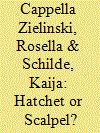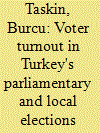|
|
|
Sort Order |
|
|
|
Items / Page
|
|
|
|
|
|
|
| Srl | Item |
| 1 |
ID:
168428


|
|
|
|
|
| Summary/Abstract |
Budgetary cuts are characterized by distinct political, organizational, and psychological dynamics in contrast to increases. Ideally, policymakers rank, prioritize, and assess among likely strategic challenges to identify the appropriate offices, programs, line items, or service branches in which to curtail spending. Targeted cuts—preserving some line items or services while cutting others—occurred during the Eisenhower, Kennedy, Ford, and Clinton administrations. In contrast, the Nixon, H.W. Bush, and Obama administrations implemented across-the-board cuts, impacting all areas of the budget uniformly, regardless of strategic priorities. We argue that the ability of the executive to target and redirect spending commensurate with national security needs are constrained by domestic interests. However, the degree to which the threat environment is diverse conditions the number of available policy options and, in turn, executive capacity to implement targeted cuts vis-à-vis parochial interests.
|
|
|
|
|
|
|
|
|
|
|
|
|
|
|
|
| 2 |
ID:
142292


|
|
|
|
|
| Summary/Abstract |
This study evaluates the influence of party competitiveness, number of parties and intervention of non-elected actors, as well as socio-economic and institutional factors, with respect to voter turnout in Turkish parliamentary and local elections. While statistical results contradicted expectations, the application of compulsory voting proved to be the single most important determinant for an increase in voter turnout, whereas electoral type and electoral system difference become insignificant for electoral participation motivation. The first democratic elections following a military intervention generally shows a significant jump in voter turnout, but it also causes a decrease in the number of parties and diminishes party competition for the following electoral terms. Large numbers of registered voters and high voter turnout motivate parties to compete in the elections. Nevertheless, lack of party competition and a 10 percent electoral threshold enable only a few parties to take a piece of this enormous electoral pie.
|
|
|
|
|
|
|
|
|
|
|
|
|
|
|
|
|
|
|
|
|